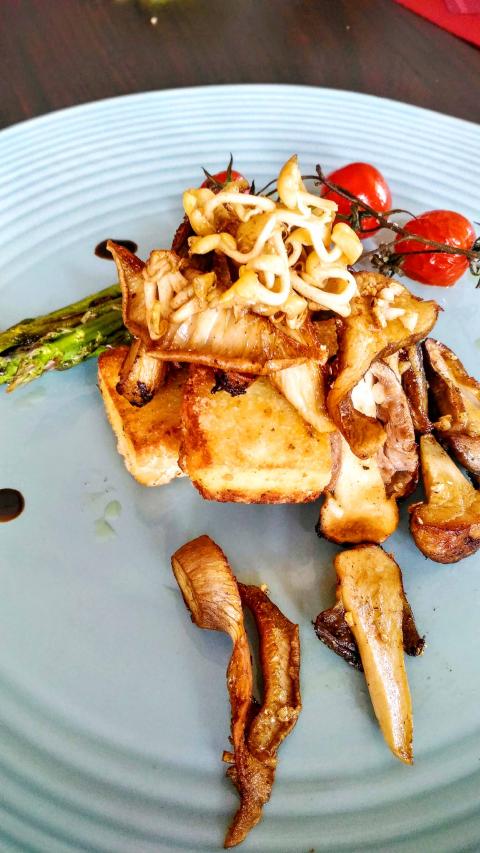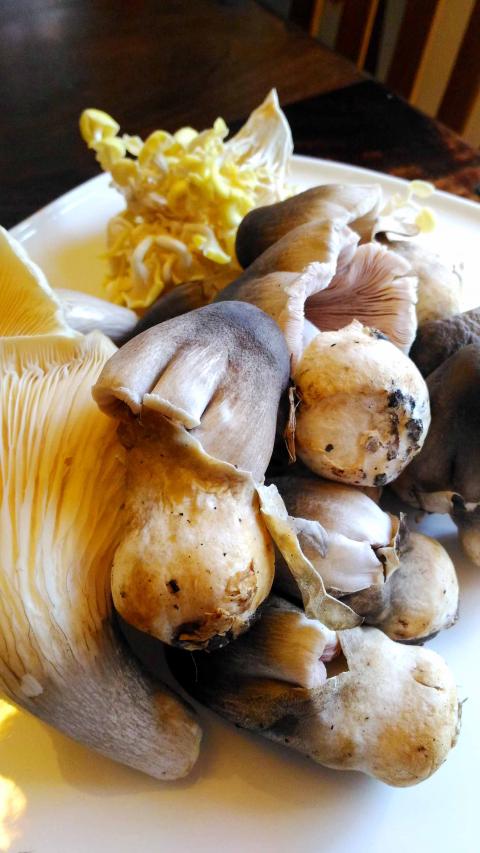It is always a delight to find fresh straw mushrooms in the markets. The fact is, I am a total sucker for any kind of wild mushrooms, bringing back bags of unidentified fungus that some old lady running a vegetable stand has assured me is delicious when fried, grilled or made into soup. I have had variable success with these anonymous mushrooms, so it is with some satisfaction that I am able to confidently identify straw mushrooms.
Straw mushrooms are the common name of Volvariella volvacea, also known as paddy straw mushrooms. The name comes from the fact that they traditionally are cultivated in beds of rice straw. They have a distinctive musty flavor that many food Web sites suggest as being the reason for their lack of popularity in Western cuisines.
Straw mushrooms are widely cultivated throughout Asia but they do not feature much in Taiwanese food, and seem more popular with immigrant Vietnamese and Thai communities. I recognized straw mushrooms from the label on canned mushrooms that are widely available in Asian supermarkets in Australia, where I grew up. In this form, they never had much appeal for me, having lost much of their flavor and acquiring a slimy quality from the processing.

Photo: Ian Bartholomew
Seeing fresh straw mushrooms appearing regularly in the markets here, my mycophilia kicked in as I sought for ways to include them in the family diet. Unlike the king oyster mushroom, which I wrote about last year (Taipei Times, Aug. 8, 2015), I have yet to find fresh straw mushrooms sold at supermarkets. This may simply be a result of their delicacy, with attempts to store them for more than a day or so usually ending with the whole batched tossed out as inedible, the flesh becoming slimy, wet and suffused with the stink of sulfur. Not nice.
It is also worth noting that the straw mushroom can bear a resemblance to Amanita phalloides, commonly known as the death cap, one of the most toxic mushrooms in the world. In 2012, an incident involving the misidentification of straw mushrooms by Chinese immigrants in Australia lead to a number of deaths. This was not an isolated incident. While it is unlikely that you will pick up a deadly mushroom at a Taiwan market, foragers should exercise care.
Straw mushrooms are often sold in the “egg stage,” a dense ball of musty, earthy goodness wrapped in a delicate skin of mottled eggshell white and black. In this condition they are described as “unpeeled,” and look like quail’s eggs lurking temptingly amid other ingredients. Larger mushrooms, with the caps more fully formed are also sometimes available, and cut in half are also very attractive on the plate once you get beyond the slightly phallic imagery.

Photo: Ian Bartholomew
It is no surprise, given their appearance, that Chinese medical lore attributes the straw mushroom with the ability to enhance sexual performance. On a more mundane level, it is also supposed to benefit the liver and aid digestion. They are rich in vitamins of the B group, as well as potassium, zinc and copper.
Straw Mushrooms with Fried Polenta
Recipe
(serves two)
While this dish is gussied-up with the use of grilled polenta, the fried mushrooms are also perfectly fine on a slice of buttered toast for a mid-morning or midnight snack. I believe the generous use of olive oil and butter are key to giving this simple fry up a decadent lusciousness, and not wanting to mess with the flavors of the mushrooms, have transferred the herbal hints into the fried polenta, which also provides a crunchy crust and soft, comforting middle that is a perfect foil to the earthy notes of the mushrooms. While many laud the better flavor of traditional polenta, instant polenta works fine for this dish. Asparagus is currently in season and also makes a splendid addition.
Ingredients
For the mushrooms
200g fresh straw mushrooms
100g fresh abalone mushrooms
4 cloves garlic, minced
a generous glug olive oil
a large knob of butter (30g at least, but more if desired)
salt and pepper to season
For the grilled polenta
100g polenta
400ml stock
1 tsp minced thyme
1 tsp minced rosemary
1/4 cup grana padano or other hard cheese, grated
1/2 tsp ground pepper
1/2 tsp salt
1/2 cup flour
Glug of vegetable oil
Roasted asparagus (optional)
Aged balsamic vinegar (optional)
Directions
1. Generously butter a spring form cake tin or line a Pyrex tray with plastic wrap.
2. Bring the vegetable stock to a boil and then whisk in the polenta. Depending on the type of polenta you use, adjust the amount of liquid to achieve a thick consistency. Add thyme, rosemary, and cheese. Season with salt and pepper.
3. Put the polenta into the cake tin or tray, using a spatula to smooth the top.
4. Allow to cool, then refrigerate for at least 2 hours. This can be done a day in advance.
5. Once chilled, cut the polenta into thick slices.
6. Season the flour with salt and coat the polenta slices.
7. Heat the oil in a skillet and fry the polenta for about 2 minutes a side, until golden brown.
8. Heat olive oil in a large skillet and add butter. Put in the mushrooms. Do not crowd the pan. There should be plenty of space, otherwise the mushrooms will steam rather than fry. Do not stir for a minute or so, allowing the mushrooms to get some color, then use tongs to turn them over. Add more butter if you feel the pan is drying out.
9. When the mushrooms begin to color, add garlic and season with salt and pepper. Fry the mushrooms until they are a deep golden brown.
10. Spoon the mushrooms over the grilled polenta and serve with roast asparagus and a few drops of aged balsamic vinegar.
Ian Bartholomew runs Ian’s Table, a small guesthouse in Hualien. He has lived in Taiwan for many years writing about the food scene and has decided that until you look at farming, you know nothing about the food you eat. He can be contacted at Hualien202@gmail.com.

The unexpected collapse of the recall campaigns is being viewed through many lenses, most of them skewed and self-absorbed. The international media unsurprisingly focuses on what they perceive as the message that Taiwanese voters were sending in the failure of the mass recall, especially to China, the US and to friendly Western nations. This made some sense prior to early last month. One of the main arguments used by recall campaigners for recalling Chinese Nationalist Party (KMT) lawmakers was that they were too pro-China, and by extension not to be trusted with defending the nation. Also by extension, that argument could be

Aug. 4 to Aug. 10 When Coca-Cola finally pushed its way into Taiwan’s market in 1968, it allegedly vowed to wipe out its major domestic rival Hey Song within five years. But Hey Song, which began as a manual operation in a family cow shed in 1925, had proven its resilience, surviving numerous setbacks — including the loss of autonomy and nearly all its assets due to the Japanese colonial government’s wartime economic policy. By the 1960s, Hey Song had risen to the top of Taiwan’s beverage industry. This success was driven not only by president Chang Wen-chi’s

Last week, on the heels of the recall election that turned out so badly for Taiwan, came the news that US President Donald Trump had blocked the transit of President William Lai (賴清德) through the US on his way to Latin America. A few days later the international media reported that in June a scheduled visit by Minister of National Defense Wellington Koo (顧立雄) for high level meetings was canceled by the US after China’s President Xi Jinping (習近平) asked Trump to curb US engagement with Taiwan during a June phone call. The cancellation of Lai’s transit was a gaudy

The centuries-old fiery Chinese spirit baijiu (白酒), long associated with business dinners, is being reshaped to appeal to younger generations as its makers adapt to changing times. Mostly distilled from sorghum, the clear but pungent liquor contains as much as 60 percent alcohol. It’s the usual choice for toasts of gan bei (乾杯), the Chinese expression for bottoms up, and raucous drinking games. “If you like to drink spirits and you’ve never had baijiu, it’s kind of like eating noodles but you’ve never had spaghetti,” said Jim Boyce, a Canadian writer and wine expert who founded World Baijiu Day a decade